Market Overview
The Global Contactless Biometrics Technology Market size is estimated to be valued at USD 21.5 billion in 2025 and is further anticipated to reach USD 101.0 billion by 2034 at a CAGR of 18.8%.
Contactless biometrics refers to a category of biometric identification and authentication technologies that operate without the need for physical contact between the user and the device. These systems capture biometric traits such as facial features, iris patterns, voice, or palm vein structures using sensors, cameras, or microphones from a distance or with minimal user intervention.
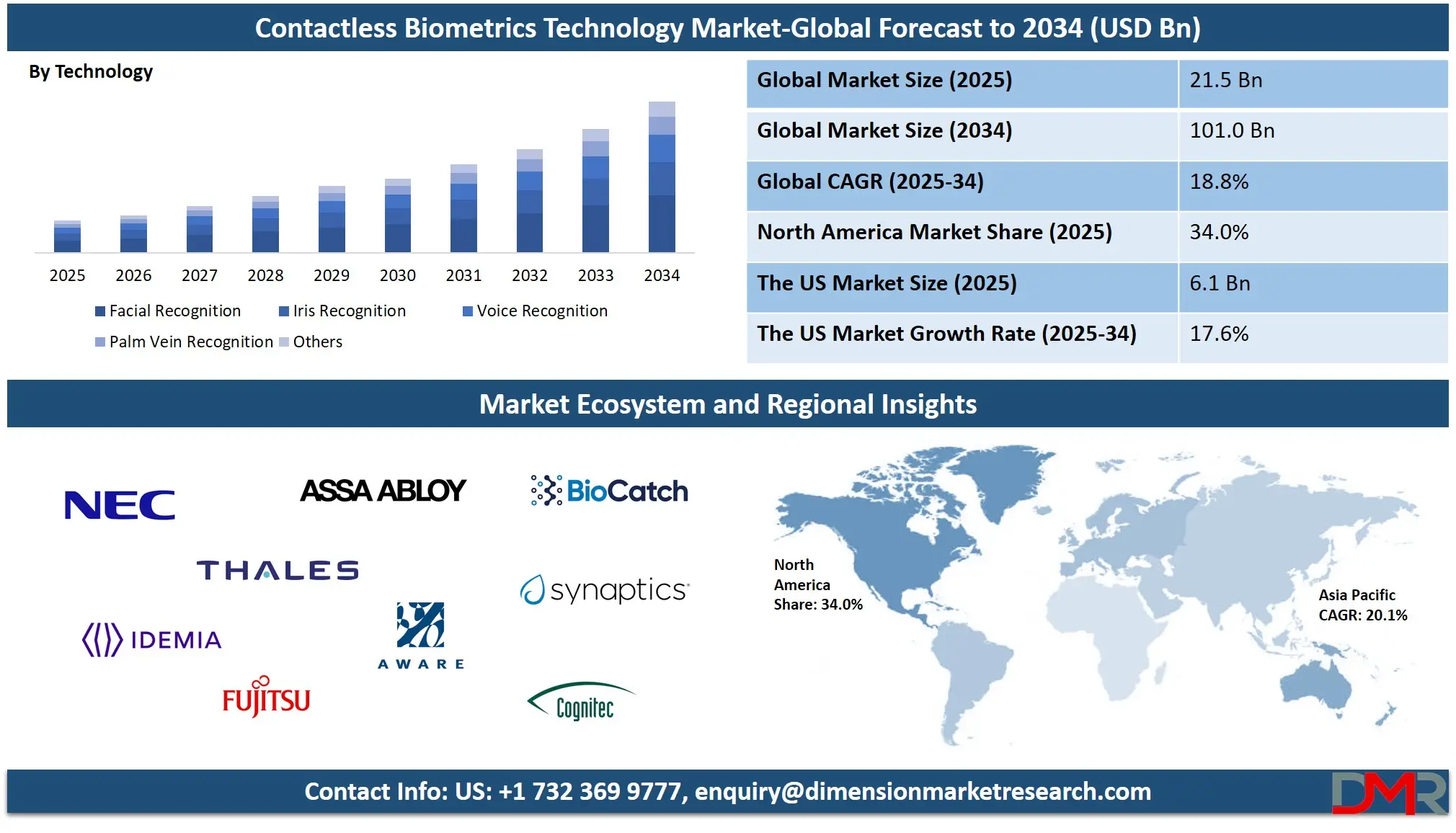
The technology offers a hygienic, efficient, and seamless way to verify identity, making it particularly relevant in environments where speed, convenience, and hygiene are critical. Unlike traditional fingerprint scanners or hand geometry systems that require touch, contactless biometrics enhances user experience and reduces the risk of disease transmission, while still ensuring high levels of accuracy and security.
The global contactless biometrics market is experiencing rapid growth due to the rising demand for secure, non-intrusive, and user-friendly identity verification solutions across various sectors. Industries such as government, banking, healthcare, transportation, and consumer electronics are adopting technologies like facial recognition, voice authentication, and iris scanning to streamline processes and enhance security.
The acceleration of digital transformation, especially in response to global health concerns and the need for touch-free interfaces, has further catalyzed market adoption. As mobile and cloud-based biometric applications gain traction, the integration of artificial intelligence and machine learning is also improving the speed and reliability of these systems.
This market is also being shaped by growing regulatory support for digital identity programs and the expansion of smart city projects worldwide. Additionally, deploying biometric access control systems in airports, public spaces, and border checkpoints underscores the growing reliance on contactless solutions for large-scale public safety and identity management.
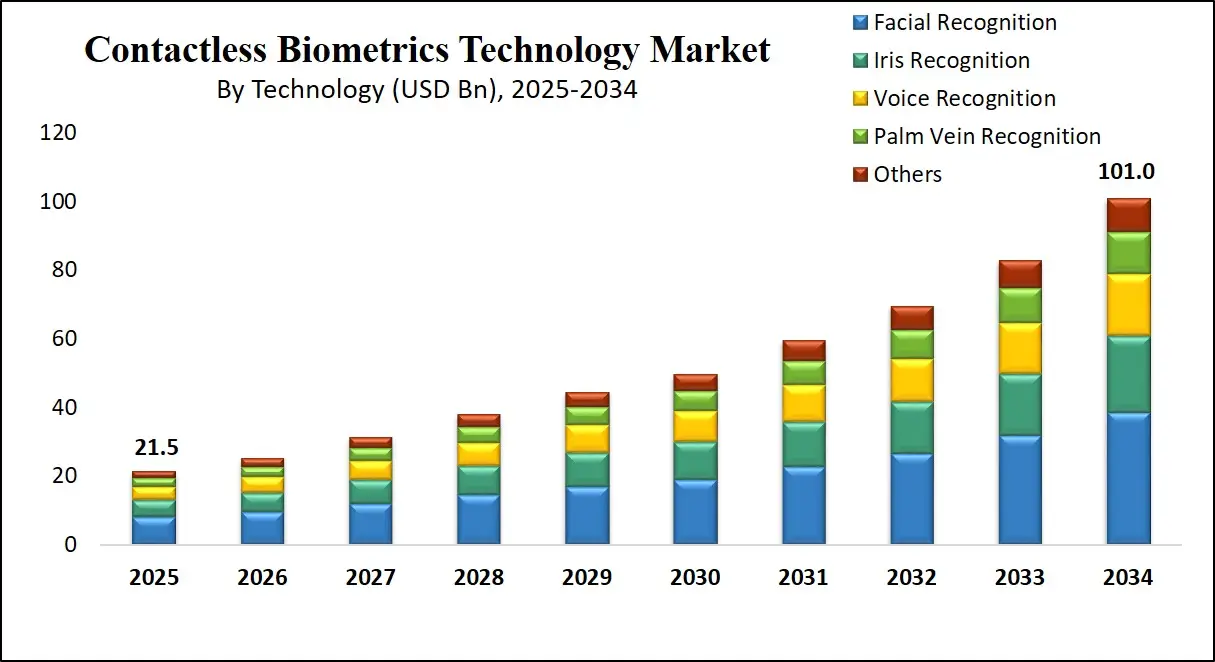
Key market trends include the shift toward multimodal biometrics, real-time surveillance, and the development of privacy-preserving biometric algorithms. As cybersecurity threats evolve, organizations are turning to biometric authentication to reduce password dependency and bolster their zero-trust security frameworks, reinforcing the critical role of contactless biometrics in the modern digital ecosystem.
The US Contactless Biometrics Technology Market
The U.S. Contactless Biometrics Technology Market size is projected to be valued at USD 6.1 billion in 2025. It is further expected to witness subsequent growth in the upcoming period, holding USD 26.5 billion in 2034 at a CAGR of 17.6%.
The United States contactless biometrics technology market is witnessing accelerated growth driven by increased adoption across government, defense, and commercial sectors. Federal agencies are actively integrating touchless identification systems such as facial recognition, iris scanning, and voice authentication for applications in border security, law enforcement, and airport passenger screening.
The expansion of e-governance initiatives and digital identity verification programs has further propelled the deployment of contactless solutions that offer secure, fast, and hygienic identity management. Additionally, growing public concerns around data privacy and contact hygiene have influenced both policy and consumer behavior, encouraging the shift from traditional fingerprint-based systems to contactless alternatives that leverage advanced image processing and biometric algorithms.
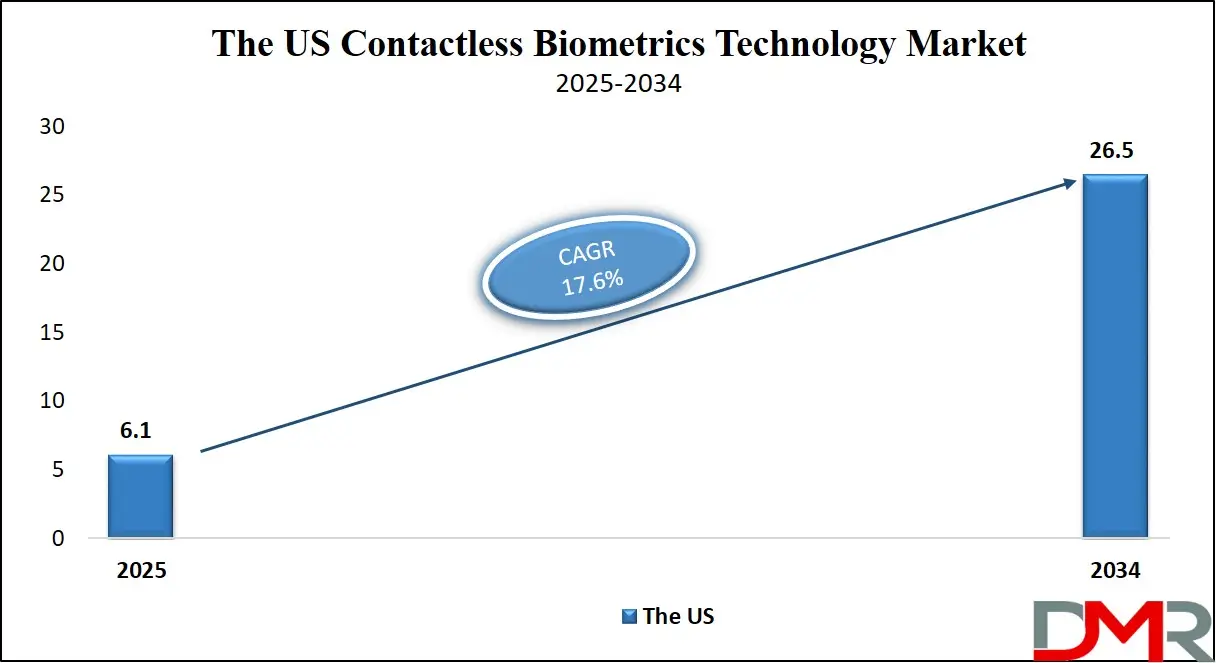
In the commercial domain, sectors such as financial services, healthcare, and retail are utilizing AI-enabled biometric authentication to enhance customer onboarding, secure mobile payments, and streamline access control systems. The rise in cyber threats and regulatory compliance requirements, such as KYC and HIPAA, has further cemented the need for frictionless and secure biometric systems.
The U.S. is also home to several leading biometric technology providers and startups, fostering innovation in multimodal contactless solutions. With widespread 5G adoption and growing integration of cloud-based identity platforms, the U.S. market is positioned as a key driver of the global contactless biometrics landscape, combining technological maturity with strong infrastructure support.
The Europe Contactless Biometrics Technology Market
In 2025, the Europe contactless biometrics technology market is projected to be valued at approximately USD 5.3 billion. This substantial share reflects the region's strong commitment to secure and privacy-compliant identity management solutions across sectors such as government, law enforcement, banking, and healthcare.
European nations are rapidly advancing digital identity programs, biometric border screening systems, and e-passport initiatives that rely on facial recognition, iris scanning, and voice authentication technologies. The implementation of GDPR and other stringent data protection laws has further encouraged the adoption of highly secure and decentralized contactless biometric solutions, particularly in public services and fintech sectors where user consent and data transparency are critical.
With a projected CAGR of 17.5% from 2025 to 2034, Europe is positioned for steady growth in this sector. This expansion is driven by growing investments in smart city infrastructure, public surveillance systems, and AI-enabled identity verification platforms. Countries like Germany, France, the UK, and the Nordics are leading this transformation by integrating biometric authentication into daily use cases such as ticketing, workplace access, and healthcare management.
Additionally, cross-border collaboration within the EU on biometric standardization and interoperability is creating a unified digital identity ecosystem, further accelerating market momentum. As contactless biometrics become central to digital transformation strategies, Europe will continue to be a key contributor to global market advancement.
The Japan Contactless Biometrics Technology Market
Japan's contactless biometrics technology market is expected to reach a value of approximately USD 1.3 billion in 2025, accounting for a notable share of the global landscape. This growth is fueled by the country’s ongoing push toward digitization, automation, and security in both public and private sectors.
The Japanese government has integrated biometric authentication into various national programs, such as the “My Number” digital ID system and smart city initiatives, while also encouraging the use of facial and iris recognition technologies in transportation hubs, banking services, and healthcare facilities. High-tech rail stations, airports, and public offices utilize contactless systems to enhance user convenience, improve operational efficiency, and reduce identity fraud.
With a forecast CAGR of 15.8% between 2025 and 2034, Japan’s market growth is supported by strong demand for advanced technology solutions tailored to its aging population and urban infrastructure. Major domestic firms are also investing in biometric innovations integrated into consumer electronics, ATMs, and mobile applications, further broadening the scope of use.
However, cultural sensitivity around data privacy and mass surveillance has led to cautious deployment in some areas, making growth more measured compared to other Asian markets. Nevertheless, Japan’s commitment to AI-driven identity authentication and secure digital services ensures continued expansion and technological leadership in the contactless biometrics space.
Key Takeaways
- Market Value: The global contactless biometrics technology market size is expected to reach a value of USD 101.0 billion by 2034 from a base value of USD 21.5 billion in 2025 at a CAGR of 18.8%.
- By Component Segment Analysis: Hardware components are anticipated to dominate the component segment, capturing 47.0% of the total market share in 2025.
- By Mode of Deployment Segment Analysis: On-Premise deployment mode is poised to consolidate its dominance in the mode of deployment segment, capturing 53.0% of the total market share in 2025.
- By Technology Segment Analysis: Facial Recognition technology is expected to maintain its dominance in the technology segment, capturing 38.0% of the total market share in 2025.
- By Application Segment Analysis: Access Control applications will dominate the application segment, capturing 34.0& of the market share in 2025.
- By End-Use Industry Segment Analysis: The Government & Defense industry will lead in the end-use industry segment, capturing 30.0% of the market share in 2025.
- Regional Analysis: North America is anticipated to lead the global contactless biometrics technology market landscape with 34.0% of total global market revenue in 2025.
- Key Players: Some key players in the global contactless biometrics technology market are NEC Corporation, Thales Group, IDEMIA, Fujitsu Limited, Assa Abloy AB, Aware Inc., Gemalto (Thales), Cognitec Systems GmbH, BioCatch Ltd., Synaptics Incorporated, HID Global, Qualcomm Technologies Inc., FaceFirst Inc., and Other Key Players.
Use Cases
- Airport Security and Passenger Processing: Airports around the world are adopting contactless biometric systems to streamline passenger flow, enhance security, and reduce physical contact during identity checks. Facial recognition technology integrated with e-passport systems enables passengers to move through immigration and boarding gates with minimal delays. Contactless identity verification at self-service kiosks and boarding points not only enhances passenger experience but also supports compliance with international security standards. AI-powered biometric surveillance and thermal facial recognition further improve situational awareness, helping authorities monitor for security threats while ensuring hygienic travel experiences.
- Digital Banking and Financial Authentication: Financial institutions are leveraging contactless biometrics to secure digital banking platforms and simplify customer authentication. Biometric modalities such as voice recognition, facial scanning, and behavioral biometrics are being used for secure onboarding, e-KYC compliance, and transaction validation. These solutions replace traditional passwords and OTPs with frictionless, real-time identity verification, reducing fraud and improving user experience. Mobile banking apps are integrating multimodal biometrics to authenticate users across devices, driven by the need for stronger cybersecurity and regulatory requirements for anti-money laundering and digital fraud prevention.
- Contactless Access Control in Healthcare Facilities: Hospitals and clinics are deploying contactless biometric access control systems to protect sensitive zones, safeguard patient data, and ensure staff accountability. Technologies such as iris and palm vein recognition provide hygienic, high-accuracy authentication without the need for touch-based credentials or cards. These systems are crucial for managing access to restricted areas such as operating rooms, pharmacies, and patient records. Additionally, facial recognition is being used for patient check-ins and visitor management, reducing wait times and enhancing safety during health crises such as pandemics.
- Smart City Surveillance and Public Safety: Governments and urban planners are integrating contactless biometrics into smart city infrastructure to enhance public safety, monitor high-traffic areas, and manage urban mobility. Facial recognition cameras equipped with AI analytics are used in real-time surveillance for criminal detection, crowd control, and missing persons identification. Contactless biometric authentication also enables secure citizen access to e-government services and transportation systems. The scalability and speed of these systems make them ideal for managing population data and improving emergency response efficiency in large urban environments.
Impact of Artificial Intelligence in Contactless Biometrics Technology Market
Artificial intelligence is accelerating the evolution of contactless biometrics by significantly enhancing recognition accuracy, authentication speed, and fraud detection in touchless systems. AI-driven algorithms, including deep learning and neural networks, can process facial, iris, and gesture recognition data in real time, even under variable lighting, angles, and occlusions.
This improves reliability in high-security environments like airports, financial services, and smart buildings. AI also enables dynamic template learning, where systems adapt and update biometric profiles continuously, reducing false positives and expanding inclusivity across diverse demographics. Coupled with edge computing, AI-powered contactless biometrics deliver rapid, private, and seamless authentication workflows that support pandemic-safe interactions and elevate user experience.
Stats & Facts
-
United States – U.S. Department of Homeland Security (DHS), Customs and Border Protection (CBP), and Government Accountability Office (GAO)
- Over 193 million travelers have been processed using biometric facial comparison technology at U.S. ports of entry by 2024.
- CBP has identified more than 1,500 cases of identity fraud using biometric verification at borders.
- DHS and DOJ have deployed multiple contactless biometric modalities including facial recognition, iris scans, and contactless fingerprints for immigration, employee verification, and border control purposes.
-
India – Ministry of Civil Aviation (Digi Yatra Initiative)
- Digi Yatra, India’s facial recognition-based airport check-in program, was operational at 15 airports by early 2024, with 13 more expected by April 2024.
- The initiative had enrolled over 1 million travelers by mid-2023, promoting seamless, contactless passenger movement and verification.
Market Dynamics
Global Contactless Biometrics Technology Market: Driving Factors
Rising Demand for Touchless Identity Authentication in Public Safety and Healthcare
The growing need for secure and hygienic identity verification has led to widespread adoption of contactless biometric technologies in sectors like healthcare and law enforcement. Amid concerns over disease transmission, facial recognition and iris scanning offer non-intrusive alternatives to fingerprinting for use in hospitals, border control, and high-security zones. These technologies not only improve operational efficiency but also help ensure accurate identity authentication, reducing fraud and administrative errors in critical services.
Surge in Digital Transformation and Mobile Biometrics Integration
The global shift toward digital ecosystems has fueled demand for secure mobile-based authentication. Smartphones and wearable devices now support biometric security features such as voice recognition, facial unlock, and behavioral biometrics. Organizations across banking, e-commerce, and education are integrating mobile-friendly identity solutions to support remote access, digital onboarding, and contactless transactions. This trend is further accelerated by the increased penetration of smartphones and the growing preference for user-centric, frictionless authentication.
Global Contactless Biometrics Technology Market: Restraints
High Implementation Costs and Infrastructure Dependency
Despite its benefits, the deployment of advanced contactless biometric systems requires significant capital investment in hardware, software, and integration infrastructure. Small and medium enterprises (SMEs) and organizations in developing economies often face budget constraints, which limit widespread adoption. Additionally, legacy IT systems may require upgrades to accommodate AI-powered biometric surveillance and cloud-based identity verification solutions, adding further complexity.
Privacy Concerns and Regulatory Hurdles
The collection and processing of biometric data raises significant concerns related to user privacy, data misuse, and government surveillance. Regulatory frameworks such as GDPR in Europe and CCPA in California impose strict compliance obligations on companies, often limiting real-time data sharing and cross-border transfers. Without clear legal guidelines and transparency in biometric data use, user trust remains a key barrier, slowing down adoption across industries.
Global Contactless Biometrics Technology Market: Opportunities
Expansion of Biometric Access Control in Smart Cities and Transportation
The global push toward smart city development offers immense opportunities for integrating contactless biometrics in urban infrastructure. Public transportation systems, airports, and government facilities are deploying AI-based facial recognition and palm vein scanners to manage access and streamline passenger flow. These systems enhance public safety and improve operational efficiency, making them attractive investments for municipal authorities and urban planners.
Integration with Blockchain and Decentralized Digital Identity Systems
There is growing interest in combining contactless biometrics with blockchain to create secure, decentralized digital identity systems. These solutions ensure data integrity and prevent identity theft by allowing users to retain control over their biometric information. Applications range from secure voting platforms to blockchain-based health records and cross-border digital identities, particularly in regions lacking robust identification frameworks.
Global Contactless Biometrics Technology Market: Trends
Adoption of Multimodal Biometrics for Enhanced Security
Organizations are deploying multimodal systems that combine two or more biometric modalities such as facial recognition, voice print, and iris scans. This layered approach enhances the accuracy and reliability of identity verification, especially in high-risk environments. Multimodal solutions also reduce false positives and make spoofing more difficult, strengthening cybersecurity and access control mechanisms.
Growth of AI-Powered Behavioral Biometrics and Continuous Authentication
Beyond traditional identifiers, behavioral biometrics such as typing rhythm, mouse movement, and gesture dynamics are gaining traction. These solutions use machine learning algorithms to analyze user behavior patterns for continuous authentication. Particularly useful in fintech and enterprise applications, this trend supports real-time fraud detection and seamless user experiences without repeated identity prompts.
Research Scope and Analysis
By Component Analysis
In the contactless biometrics technology market, hardware components are expected to hold the largest share of the component segment, accounting for approximately 47.0% of the total market in 2025. This dominance is primarily due to the widespread deployment of biometric sensors, cameras, scanners, and other physical devices that are essential for capturing biometric data such as facial features, iris patterns, or palm vein structures.
As demand for touch-free authentication grows across sectors like public security, healthcare, and border control, organizations are heavily investing in physical infrastructure to enable real-time biometric identification and access control. Advancements in hardware design, including miniaturized sensors and 3D imaging cameras, are also supporting greater integration of biometrics into consumer electronics, smart kiosks, and surveillance systems.
Software solutions, while slightly behind hardware in terms of share, represent a rapidly growing segment in the contactless biometrics landscape. These platforms encompass the algorithms and analytics that process, match, and secure biometric data captured by hardware devices. AI-powered software is playing a key role in improving recognition accuracy, reducing false positives, and enabling real-time decision-making in applications ranging from facial verification at airports to voice authentication in banking.
As cloud-based deployments and identity-as-a-service (IDaaS) models gain traction, software offerings are becoming more scalable, customizable, and central to multimodal biometric systems. The growing integration of machine learning, edge computing, and cybersecurity features within these software solutions is expected to drive significant value in the years ahead.
By Mode of Deployment Analysis
On-premise deployment is projected to maintain its leading position in the mode of deployment segment, securing 53.0% of the total market share in 2025. This dominance is largely attributed to the higher control, data security, and customization capabilities that on-premise solutions offer. Organizations operating in sectors such as government, defense, and critical infrastructure often prioritize full ownership of their biometric data and systems due to regulatory, compliance, and privacy concerns.
On-premise deployment allows them to manage sensitive identity verification processes internally without relying on external servers or internet connectivity. Additionally, legacy system integration and the need for stable, low-latency environments further support the continued preference for on-premise biometric infrastructure, especially in high-security environments.
Cloud-based deployment, while capturing a slightly smaller market share, is rapidly gaining popularity due to its flexibility, scalability, and cost-effectiveness. It enables organizations to implement contactless biometric solutions without significant upfront investment in physical infrastructure. Cloud platforms support remote identity management, real-time authentication, and seamless software updates, making them ideal for enterprises with distributed operations or mobile workforces.
Cloud-based biometrics also align well with the growing demand for digital onboarding and identity-as-a-service (IDaaS) offerings. As cybersecurity measures in cloud environments continue to advance and regulatory frameworks adapt to remote identity verification, more industries, including retail, education, and financial services, are expected to accelerate their transition to cloud-powered biometric authentication systems.
By Technology Analysis
Facial recognition technology is anticipated to continue leading the technology segment in the contactless biometrics market, capturing 38.0% of the total share in 2025. Its dominance is driven by its widespread adoption across both public and private sectors for real-time identity verification, surveillance, and access control. Airports, government buildings, law enforcement agencies, and even consumer electronics rely heavily on facial recognition due to its speed, non-intrusiveness, and ease of deployment.
The advancement of AI and deep learning algorithms has significantly improved facial detection accuracy, even under challenging conditions such as varied lighting or facial masks. Moreover, the integration of facial recognition into smartphones and smart security systems has further expanded its commercial use, making it one of the most scalable and accessible contactless biometric solutions.
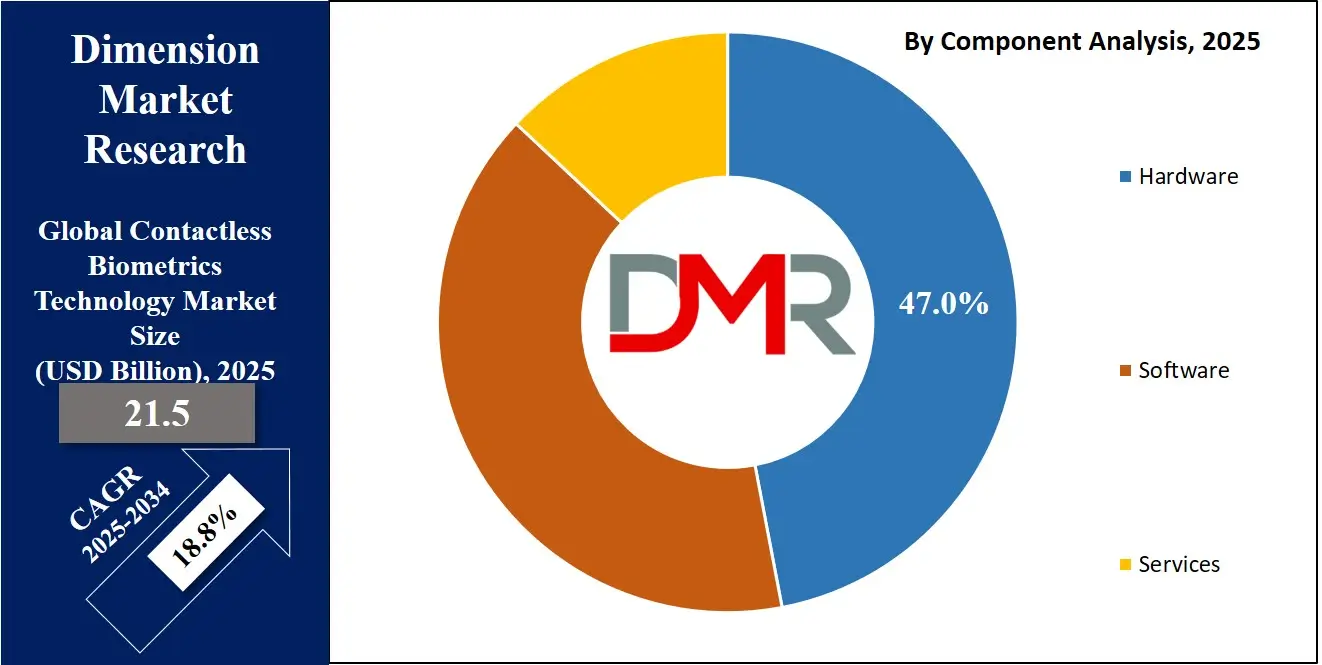
Iris recognition, while holding a smaller share of the market, is recognized for its high accuracy and reliability in secure identity authentication. It uses the unique patterns in the colored ring of the eye to verify individuals, offering excellent resistance to spoofing and minimal false acceptance rates. This technology is particularly valued in sectors that demand extremely high security, such as defense, border control, and certain healthcare and financial applications.
Although the implementation cost is typically higher than facial recognition, iris scanning is gaining traction in use cases where precision and security outweigh cost concerns. As the technology becomes more compact and affordable, its adoption is expected to grow steadily, complementing other biometric modalities in multimodal systems.
By Application Analysis
Access control is projected to dominate the application segment of the contactless biometrics technology market, accounting for 34.0% of the total market share in 2025. This is largely driven by the growing need for secure, seamless, and hygienic entry systems across various industries, including corporate offices, airports, healthcare facilities, and critical infrastructure.
Contactless biometric solutions such as facial recognition terminals, palm vein scanners, and voice-based access systems are being widely adopted to restrict unauthorized entry and monitor movement within physical spaces. These systems not only enhance security but also improve operational efficiency by eliminating the need for physical keys, cards, or touch-based verification methods. As organizations place greater emphasis on health-conscious access management and zero-trust security frameworks, demand for biometric access control is expected to continue rising.
Identity verification, while closely linked to access control, represents a broader use case that spans digital and remote interactions. It involves authenticating a person’s identity in real time during activities such as online onboarding, account creation, mobile banking, and e-government services. Contactless biometrics like facial matching, iris scanning, and voiceprint analysis are enabling businesses to securely verify users without requiring physical presence.
This has become especially relevant with the growth of digital platforms and the need to combat rising cyber threats such as identity fraud and account takeover. Identity verification is critical for regulatory compliance with KYC and AML requirements, and its demand is rapidly expanding in sectors like finance, telecom, and online education. As more services migrate online, the role of secure, contactless identity verification continues to gain strategic importance.
By End-Use Industry Analysis
The government and defense sector is set to lead the end-use industry segment in the contactless biometrics technology market, capturing 30.0% of the market share in 2025. This dominance is largely fueled by national security initiatives, border control programs, and the growing need for accurate and efficient citizen identification systems.
Governments around the world are deploying facial recognition, iris scanning, and palm vein technologies for biometric passports, e-visas, voter registration, and surveillance to enhance security and streamline administrative processes. In defense, these technologies play a crucial role in secure access to classified areas, identity management of military personnel, and real-time threat detection. As geopolitical tensions and public safety demands intensify, investments in advanced, contactless biometric systems across military bases, airports, and national databases are expected to grow steadily.
The healthcare industry is also emerging as a vital end-user of contactless biometric solutions, driven by the urgent need for secure, hygienic, and reliable patient identification methods. Hospitals and clinics are integrating facial and palm vein recognition systems to manage patient records, reduce medical errors, and ensure accurate access to sensitive health data.
These technologies help prevent identity fraud, support compliance with data protection regulations like HIPAA, and minimize administrative burdens during patient check-ins. In the wake of global health crises, the emphasis on contactless and sanitary solutions has become even more pronounced, prompting healthcare providers to adopt biometric systems not just for security but also for operational resilience and improved patient experience. As digital health services expand, the demand for biometric authentication in telehealth and electronic medical records is expected to accelerate.
The Contactless Biometrics Technology Market Report is segmented on the basis of the following
By Component
- Hardware
- Software
- Services
By Mode of Deployment
By Technology
- Facial Recognition
- Iris Recognition
- Voice Recognition
- Palm Vein Recognition
- Others
By Application
- Access Control
- Identity Verification
- Authentication
- Surveillance & Monitoring
By End-Use Industry
- Government & Defense
- Healthcare
- Banking & Financial Services
- Consumer Electronics
- Travel & Hospitality
- Retail & E-commerce
- Other
Regional Analysis
Region with the Largest Revenue Share
North America is expected to lead the global contactless biometrics technology market in 2025, accounting for 34.0% of total global market revenue. This dominance is driven by the region's early adoption of advanced biometric systems, strong presence of leading technology providers, and high investment in public safety and cybersecurity infrastructure.
Government initiatives such as e-passports, biometric border screening, and national identity programs have significantly contributed to market growth. Additionally, the widespread integration of contactless biometric solutions in sectors like banking, healthcare, and enterprise security, along with supportive regulatory frameworks, has positioned North America as a key innovator and consumer in this rapidly evolving market landscape.
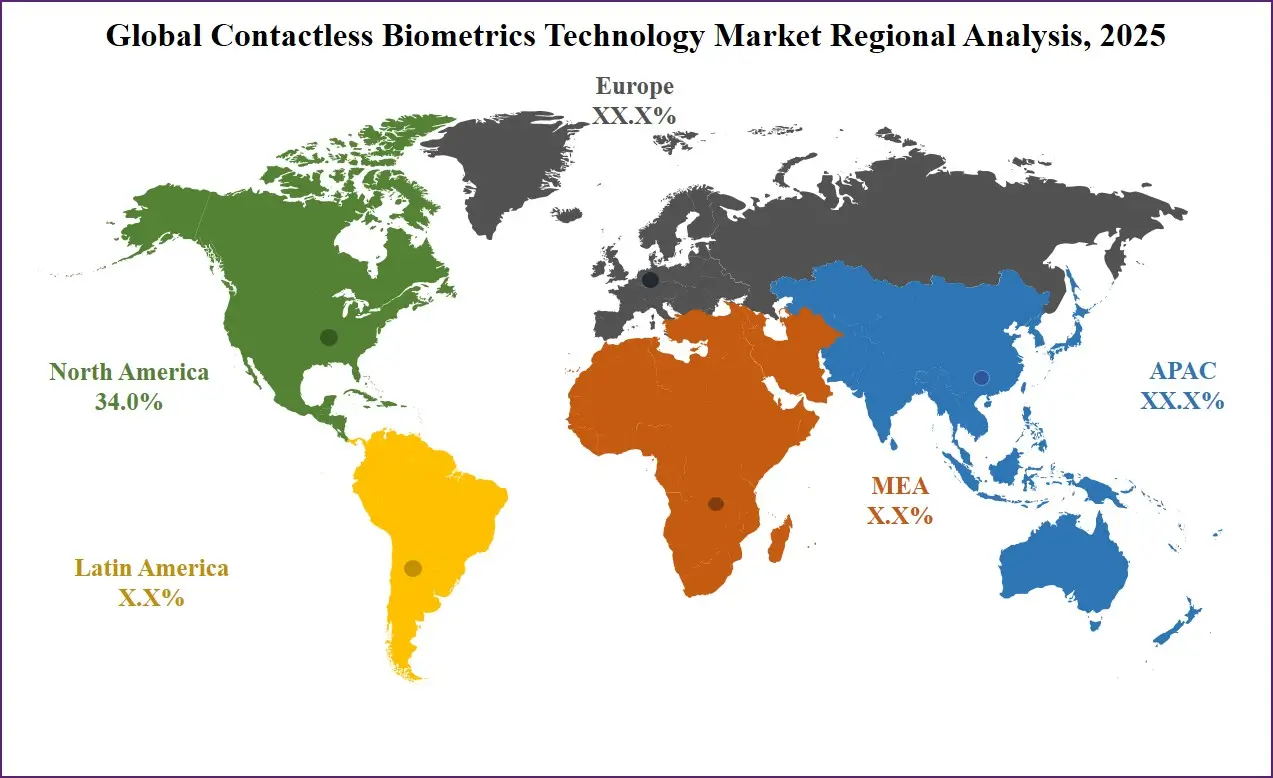
Region with significant growth
The Asia-Pacific region is projected to experience the highest CAGR in the global contactless biometrics technology market during the forecast period. This rapid growth is driven by growing government initiatives for digital identity programs, rising investments in smart city infrastructure, and growing demand for secure and touchless authentication in densely populated countries such as China, India, and Japan.
Expanding mobile and internet penetration, integrated with a surge in digital transactions and e-governance services, is further accelerating the adoption of biometric technologies across sectors like banking, transportation, and public safety. The region's favorable regulatory environment, combined with ongoing technological innovation and a booming tech-savvy population, positions Asia-Pacific as the fastest-growing market in this space.
By Region
North America
Europe
- Germany
- The U.K.
- France
- Italy
- Russia
- Spain
- Benelux
- Nordic
- Rest of Europe
Asia-Pacific
- China
- Japan
- South Korea
- India
- ANZ
- ASEAN
- Rest of Asia-Pacific
Latin America
- Brazil
- Mexico
- Argentina
- Colombia
- Rest of Latin America
Middle East & Africa
- Saudi Arabia
- UAE
- South Africa
- Israel
- Egypt
- Rest of MEA
Competitive Landscape
The global competitive landscape of the contactless biometrics technology market is highly dynamic and fragmented, characterized by the presence of both long-established players and innovative startups competing on technology innovation, scalability, and application versatility. Key industry leaders such as NEC Corporation, Thales Group, IDEMIA, and Fujitsu Limited are investing heavily in AI-driven biometric algorithms, multimodal platforms, and cloud-based identity solutions to maintain their market dominance.
Meanwhile, emerging companies are disrupting the space with niche offerings in behavioral biometrics, decentralized identity systems, and mobile-first authentication solutions. Strategic partnerships, mergers and acquisitions, and product launches are frequent as companies aim to expand their regional footprints and address the rising demand across sectors such as government, healthcare, banking, and enterprise security. The competitive edge is being defined by real-time processing capabilities, compliance with global data privacy standards, and the ability to offer seamless, secure, and contactless user experiences.
Some of the prominent players in the global contactless biometrics technology market are
- NEC Corporation
- Thales Group
- IDEMIA
- Fujitsu Limited
- Assa Abloy AB
- Aware, Inc.
- Cognitec Systems GmbH
- BioCatch Ltd.
- Synaptics Incorporated
- HID Global
- Qualcomm Technologies, Inc.
- FaceFirst, Inc.
- Nuance Communications (Microsoft)
- Precise Biometrics
- Fingerprint Cards AB
- Daon, Inc.
- M2SYS Technology
- Suprema Inc.
- Innovatrics
- Other Key Players
Recent Developments
- June 2025: Fuse Identities introduced a biometric physical access card featuring Fingerprint Cards AB’s T‑Shape sensor, designed for secure, contactless identity checks in critical infrastructure, enterprises, and temporary ID scenarios, keeping biometric data stored on the card to enhance privacy.
- June 2025: Next Biometrics unveiled its new “Granite” FAP 30 fingerprint sensor, offering a larger surface area and improved thermal technology for high-security environments across Africa, South America, and the U.S.
- April 2025: Multimodal biometrics provider Wink merged with Phoenix Managed Networks, a global payment tech firm, aiming to boost biometric adoption in omnichannel commerce.
- April 2025: IDEMIA demonstrated its leadership in travel biometrics by rolling out IATA’s Contactless Travel Directory, enhancing global access to biometric-based passenger identity systems.
- June 2025: ContinUse Biometrics secured a total of USD 21 million in funding across two rounds to support its growth in contactless biometric identification solutions.
- June 2025: Integrated Biometrics expanded its Arizona research center by 25%, adding a hands-on experience center and growing staff by 50%, signaling major internal investment in R&D.
Report Details
| Report Characteristics |
| Market Size (2025) |
USD 21.5 Bn |
| Forecast Value (2034) |
USD 101.0 Bn |
| CAGR (2025–2034) |
18.8% |
| Historical Data |
2019 – 2024 |
| The US Market Size (2025) |
USD 6.1 Bn |
| Forecast Data |
2025 – 2033 |
| Base Year |
2024 |
| Estimate Year |
2025 |
| Report Coverage |
Market Revenue Estimation, Market Dynamics, Competitive Landscape, Growth Factors, etc. |
| Segments Covered |
By Component (Hardware, Software, and Services), By Mode of Deployment (On-Premise and Cloud-Based), By Technology (Facial Recognition, Iris Recognition, Voice Recognition, Palm Vein Recognition, and Others), By Application (Access Control, Identity Verification, Authentication, and Surveillance & Monitoring), and By End-Use Industry (Government & Defense, Healthcare, Banking & Financial Services, Consumer Electronics, Travel & Hospitality, Retail & E-commerce, and Others). |
| Regional Coverage |
North America – US, Canada; Europe – Germany, UK, France, Russia, Spain, Italy, Benelux, Nordic, Rest of Europe; Asia-Pacific – China, Japan, South Korea, India, ANZ, ASEAN, Rest of APAC; Latin America – Brazil, Mexico, Argentina, Colombia, Rest of Latin America; Middle East & Africa – Saudi Arabia, UAE, South Africa, Turkey, Egypt, Israel, Rest of MEA |
| Prominent Players |
NEC Corporation, Thales Group, IDEMIA, Fujitsu Limited, Assa Abloy AB, Aware Inc., Gemalto (Thales), Cognitec Systems GmbH, BioCatch Ltd., Synaptics Incorporated, HID Global, Qualcomm Technologies Inc., FaceFirst Inc., and Other Key Players. |
| Purchase Options |
We have three licenses to opt for: Single User License (Limited to 1 user), Multi-User License (Up to 5 Users), and Corporate Use License (Unlimited User) along with free report customization equivalent to 0 analyst working days, 3 analysts working days, and 5 analysts working days respectively. |
Frequently Asked Questions
The global contactless biometrics technology market size is estimated to have a value of USD 21.5 billion in 2025 and is expected to reach USD 101.0 billion by the end of 2034.
The US contactless biometrics technology market is projected to be valued at USD 6.1 billion in 2025. It is expected to witness subsequent growth in the upcoming period as it holds USD 26.5 billion in 2034 at a CAGR of 17.6%.
North America is expected to have the largest market share in the global contactless biometrics technology market, with a share of about 34.0% in 2025.
Some of the major key players in the global contactless biometrics technology market are NEC Corporation, Thales Group, IDEMIA, Fujitsu Limited, Assa Abloy AB, Aware Inc., Gemalto (Thales), Cognitec Systems GmbH, BioCatch Ltd., Synaptics Incorporated, HID Global, Qualcomm Technologies Inc., FaceFirst Inc., and Other Key Players.
What is the growth rate of the global contactless biometrics technology market?